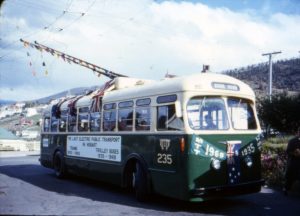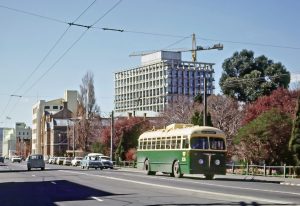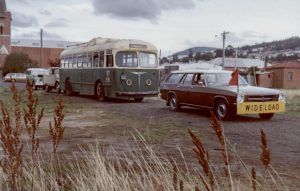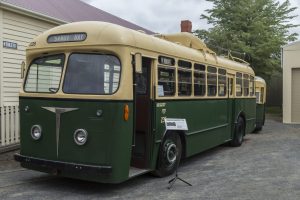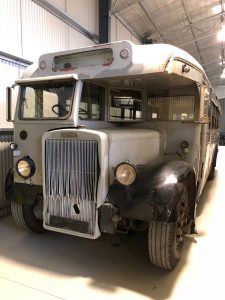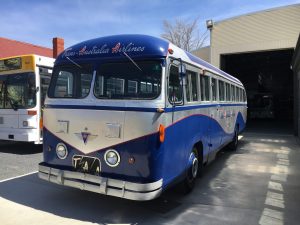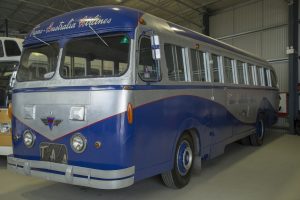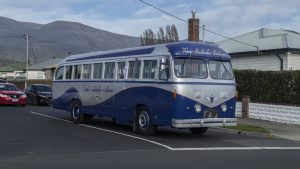Bus 601 – Leyland National
During the mid 1970s the Bedford bus fleet that had replaced the Hobart trams in the late 1950s and 1960 themselves needed replacing. Two major orders were placed with Leyland and Volvo to meet this need. The Leyland product was the Leyland National, of which 601 is the class leader of 62 other similar vehicles. The Leyland National bus is considered as quite an advanced design for the 1970s with only one step to the low floor at the front of the bus, an integral design whereby the body itself formed the strength of the vehicle, rather than having a distinct chassis and extensive use of air suspension systems. Indeed the next generation of Hobart buses from 1988 were built to the same basic design.
601 was wholly built at the specialist Leyland National factory in Workington England (where over 7000 Leyland Nationals were built) and entered service in Hobart in April 1975. Withdrawn in 1991, 601 was generously repainted by the Metropolitan Transport Trust (MTT) before being presented for preservation to the museum in 1992. Whilst 242 Leyland Nationals are documented as seeing service in Australia, only 4 are currently known to be preserved as buses in Australia (many dozens are preserved in England), with 601 and one other known to be a condition to be able to occasionally travel on public roads under their own power. Several others exist as caravans and possible restoration projects for the future.
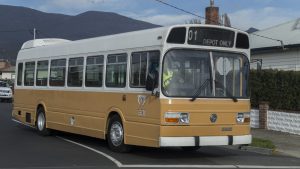
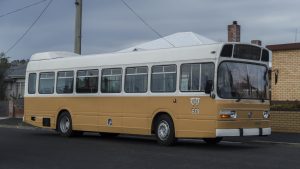
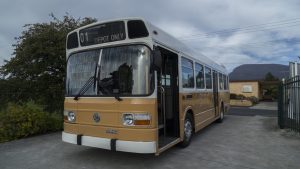
Bus 249 – Bedford
Bedford bus 249 is the last to enter service (1971) of 315 bedford petrol engined buses of a similar design that the Metropolitan Transport Trust (MTT) operated in Hobart, Launceston and Burnie from 1955 to 1988. This particular design was bodied by the Hobart firm of City Bodyworks who had been locally building specialised bus bodies since the 1930s. In line with MTT policy of the time new buses were shared between the three operations, with Hobart having nine of this type, Launceston 2 and Burnie 1. Following 249s delivery, only diesel buses have been delivered to the MTT and Metro. 249 was withdrawn from service in 1987 and kindly repainted by the MTT before being presented to the museum for preservation in 1988.
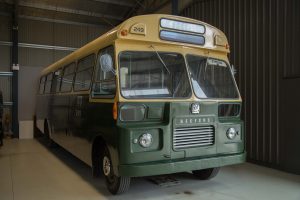
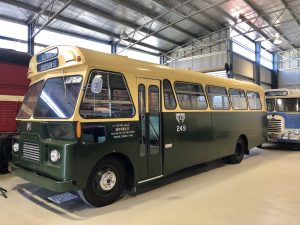
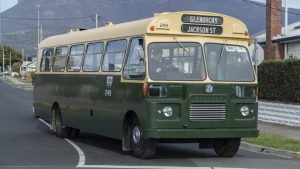
AEC Reliance
The Australian Government owned Trans Australia Airlines (TAA) was formed in 1946 and as part of its operations established connecting bus services from the centre of the cities and towns to airports it operated flights to and from until 1982. In 1956 TAA contracted Motor Body Assemblers (MBA) in Sydney to construct 20 bodies for 10 Leyland and 10 AEC imported chassis. The bus held on display is one of the 10 AEC units and was used in the Tasmanian operations of TAA until the early 1970s when it was sold to Cooks Coaches and put to work on the Hobart to Bothwell run. It was then sold to the museum for preservation (as the investment of $2000 was a substantial sum for the museum at the time, the bus was borrowed for a test run at a society general meeting before the decision to purchase was finalised) in 1985 – being our first motor bus preserved straight from service. This bus is unique in having passenger doors on both sides of the bus which is due to it being allocated to Launceston at the time of the one way street system being introduced from 1964 – it then being necessary to load and unload at the TAA city office on right of the street, rather than the traditional left side parking. It was restored to its 1950s colour scheme by museum volunteers in 2005.
Click on the link to see video of the AEC here.
Bus 361 – Leyland Tiger
Launceston City Council Tramways (LMT) ordered 4 Leyland Tiger OPS1s in 1946 for expansion of services on existing routes. Number 61 as it was then known, entered service in March 1947 , just in time to assist with the changeover from trams to motor buses of the Trevallyn route. When the Metropolitan Transport Trust (MTT) took over operations in July 1955, number 61 became 361 and was repainted into the standard Hobart colour scheme of Green and light Yellow. Retired in 1967, 361 was sold to the Hobart City Council where it was used as a mobile meal room until April 1976 when it was sold to the museum for $1. Unfortunately, the society had no undercover storage for 361 for the next 10 years or so, during which time its timber frame body deteriorated. The bus is currently undergoing restoration.
Click on the link to see Bus 361 being operated for the first time in over 10 years here.
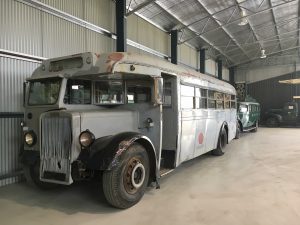
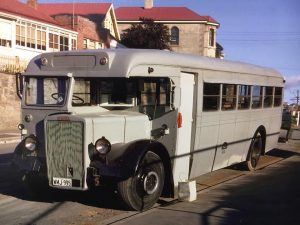
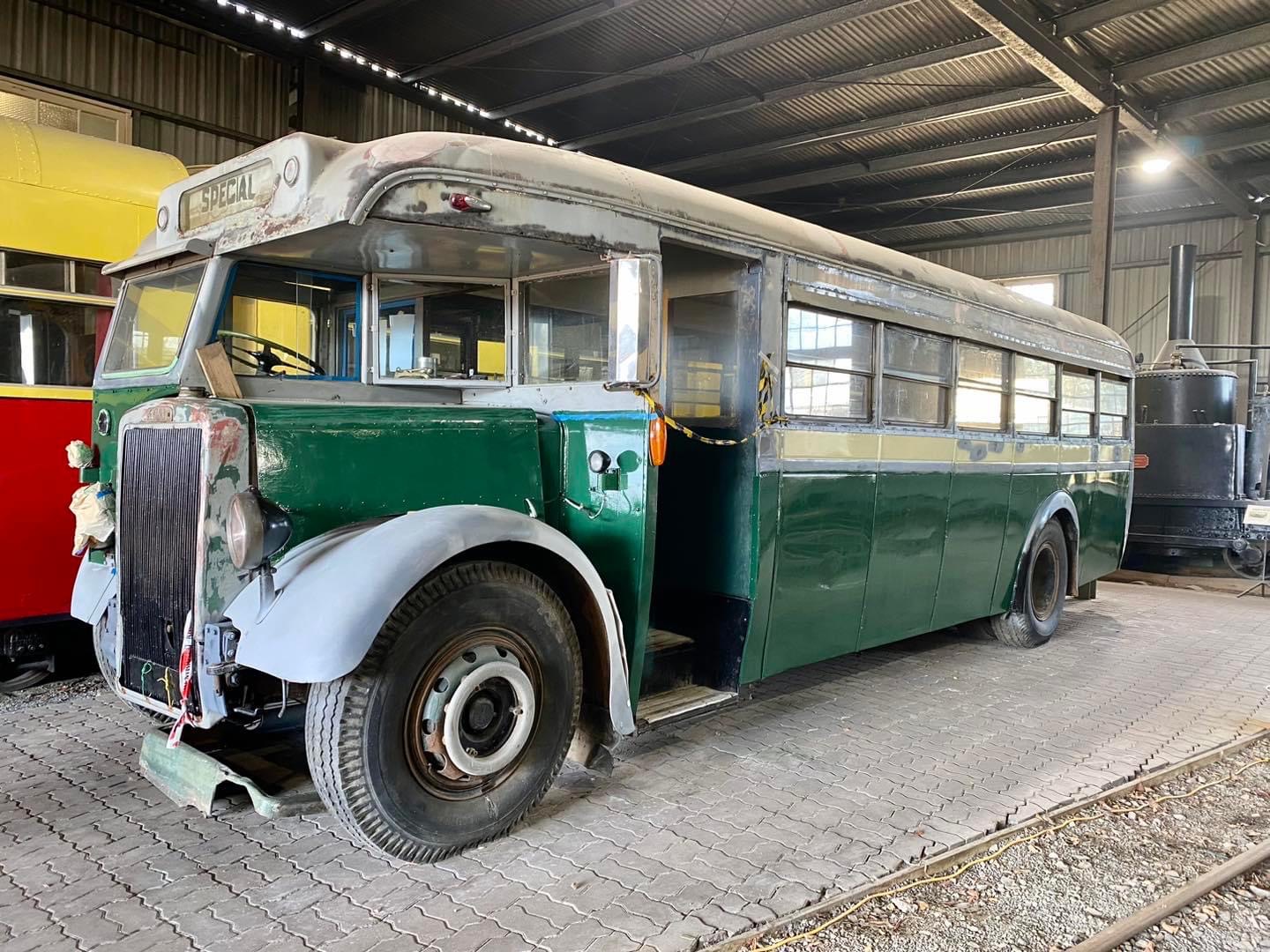
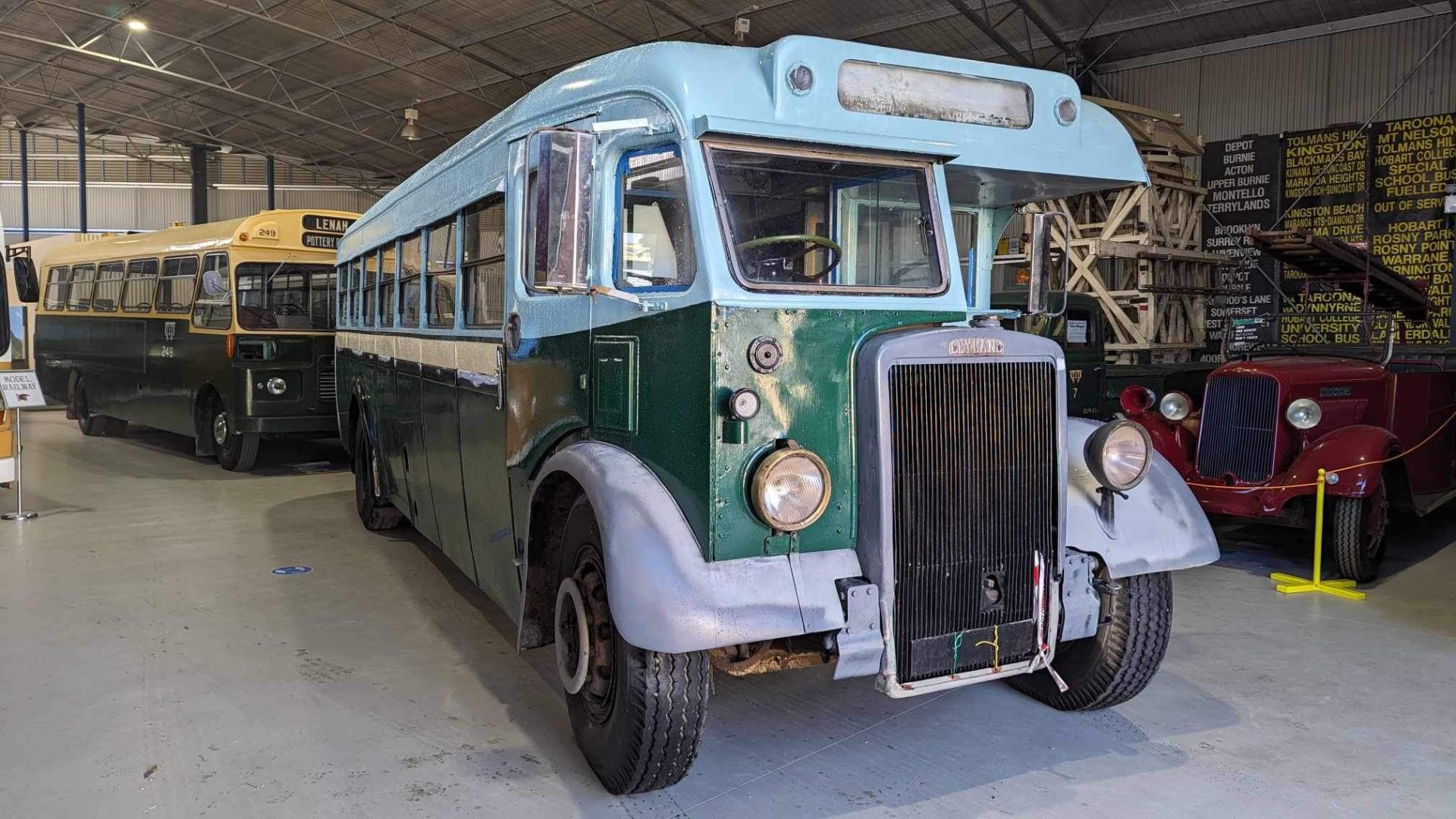
Bus 16 – AEC Regal
In parallel with a lot of Australian cities, post war 2 public transport patronage in Hobart significantly increased due to post war city growth and prolonged petrol rationing keeping private car usage quite low. In response to this, the Hobart Municipal Tramways (HMT) tripled their modest motor bus fleet size (as well as building new trams and trolley buses) between 1945 and 1950. Whilst HMT continued to locally body various bus chassis, they also contracted City Body Works to body 6 AEC Regal 1 diesel bus chassis. At the time this represented the largest group of common chassis/body buses in the Hobart motor bus fleet. Passing to the Metropolitan Transport Trust (MTT) as part of the 1955 takeover of the HMT, 16 served the greater Hobart area until April 1964, when it was sold to the Housing department. Initially used to transport workers to broad acre housing development sites, it later became a mobile meal room. Eventually, mechanical issues saw it towed between sites until donation to the museum in 1976 in fairly poor condition. In 2008, AEC Regal 3 HMT/MTT bus 32 became available in operating condition but with an extensively rotted body. Accordingly, the intention is to refurbish the mechanicals of bus 16 using the parts from bus 32 and then turn attention to the body of bus 16. As such, it is expected to be a long term restoration project.
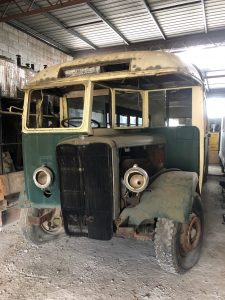
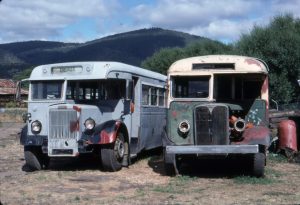
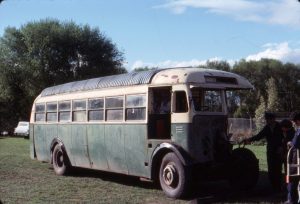
Bedford 7SB
Just prior to World War 2 – a consortium of Australia business (at the encouragement of the commonwealth government) set up the Commonwealth Aircraft Corporation (CAC). CAC served Australia well as an aircraft manufacturer but needed to diversify its product base to continue to exist. As one of the shareholders of CAC was General Motors Holden (GMH) – it was identified that a mass produced standard Australian bus had a market, and so began a partnership between CAC and GMH producing local buses (that GMH marketed) using Bedford chassis supplied through GMH. Prior to this time individual body works and often operators themselves locally bodied chassis imported on order. Starting out with the OB model and finishing with the 7SB model around 1500 buses were produced through this partnership through until 1960.
Our 7SB was sold to Brown of St Marys in 1958 who had instituted a bus service from St Helens to Launceston to replace the railways railmotor service, also running 2 other similar vehicles. The service and the bus passed to Redline during the 1960s who later on sold the bus to Derwent Valley Lines of Rosegarland for school service. Retired in 1989, the bus passed through several other owners who possibly planned various motor home conversions. Last registered in 1997, the bus was purchased by a TTMS member for preservation in 2001 before passing to the museum in 2017.
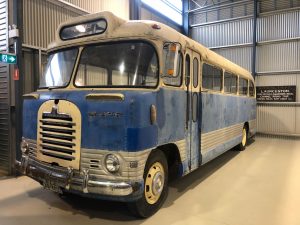
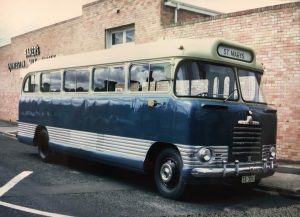
Bus 18 – Hino
Merv Creswell formed Ace buses shortly after WW2 (initially to transport patrons to dances where his Ace dance band played) and by the mid 1960s was a primary contractor to the Tasmanian Government Tourist Bureau for their “TasBureau Tours”. This led Ace Buses to have part of their operation branded as Ace Tourist Coaches, and it was under this brand that Bus 18 entered service in 1965. At that time Hino (formed in Japan in 1942 to produce military vehicles) was seeking to enter the Australian bus market and this was achieved by entering into a partnership with Freighter Industries to locally body the imported Hino chassis. Bus 18 is the first such bus/coach under this arrangement and one of the first rear engined tour coaches in Australia which lead to a much quieter ride for passengers than the traditional under floor arrangement of the time. Bus 18 continued in service (eventually as a school bus) with the Ace group until 1998 by which time it had become Mervs favourite bus and was thus retained for posterity after retirement. Upon Mervs passing, the family decided to sell the Ace Bus group (to O’Driscolls) and Bus 18 was offered to the museum where it was delivered in 2006. Hino Australia subsequently recognised the bus as part of their 50 year anniversary celebrations in 2015 and performed some mechanical upgrading at their Melbourne plant at no cost to the museum. The museum is most grateful to Hino Australia and the Cresswell family for their continued support in assisting us to keep Bus 18 able to occasionally take to the streets of Hobart for displays. Eventually it will be repainted back into its 1965 delivery colour scheme of Blue and Grey.
Hino Australia 50th anniversary celebrations with a salute to the first Hino sold in Australia. View the video here.
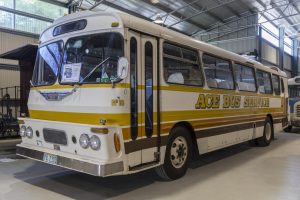
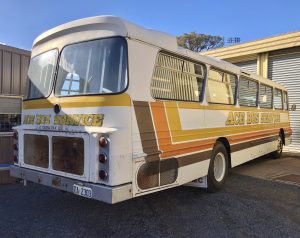
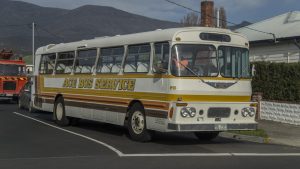
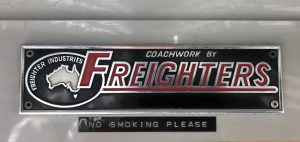
Chevrolet Side Loader
Astor Motors (later Webster Romtech Astor) had this vehicle body built locally at Cramp Brother bodyworks in 1942 on an imported Chevrolet chassis . In 1947 (also the year that Tasmanian Government Railways ceased the Apsley line service) it was sold to Wise of Bothwell who operated a Bothwell to Hobart and return service. (Cooks operated in the opposite direction). In 1967 or 1968 Wise sold his bus service into the ever growing Charles Ayers empire (later Tasmanian Coach Lines). Whilst the bus was part of the transfer, the service was upgraded to operate a flxible clipper (as it was last sideloader bus route in Tasmania), the bus was subsequently sold to a group of TTMS members in 1969 who operated it privately for a number of years including trips to places like Queenstown. As with most private bus preservation projects the bus had a number of homes in the Hobart area before being parked under a pine tree at Brighton for a period which lead to a decline in its condition and eventual donation to the Museum in 1992, arriving at the museum in June 1993. Following a period in covered storage, the bus has been externally and internally refurbished with some mechanical work and paint trim remaining to be completed.
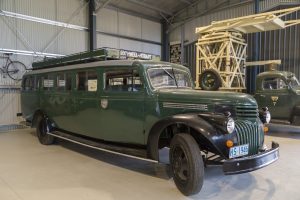
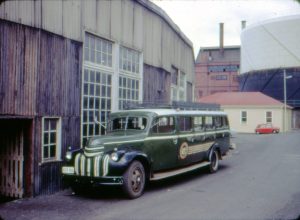
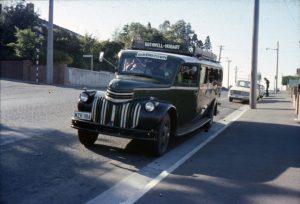
Trolley Bus 74
The Tasmanian Transport Museum owns two Hobart trolley buses, numbers 74 and 235. Number 74 has a body constructed by the then Tramway Workshops mounted onto a chassis manufactured by Leyland in England. This batch of buses are known as Canton buses, as the completed chassis were to go to China, but were sold to other cities due to the outbreak of the second world war. Number 74 was donated to the museum by the Metropolitan Transport Trust (MTT) in 1964.
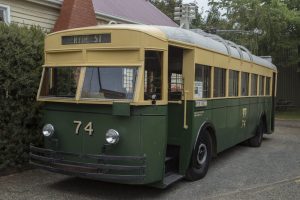
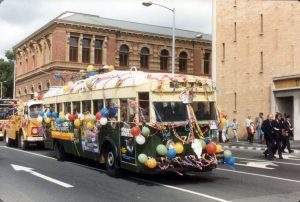
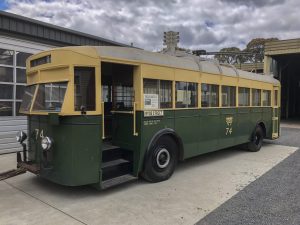
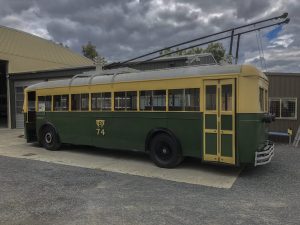
Trolley Bus 235
The second, number 235 consists of a body constructed by City Bodyworks (of Hobart) and a British United Traction (BUT) chassis, and was built in 1952. Number 235 was the last trolley bus to operate in Tasmania, and did so on 24 November 1968. It was quickly purchased by the museum, and later restored by the Metropolitan Transport Trust (MTT).

